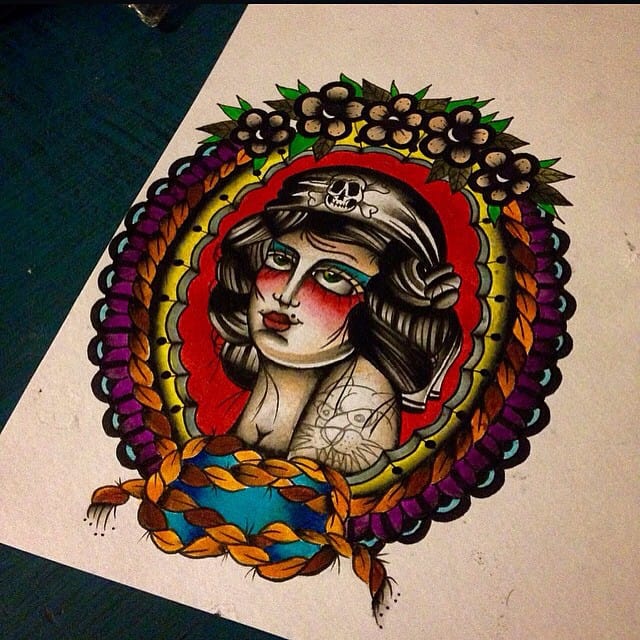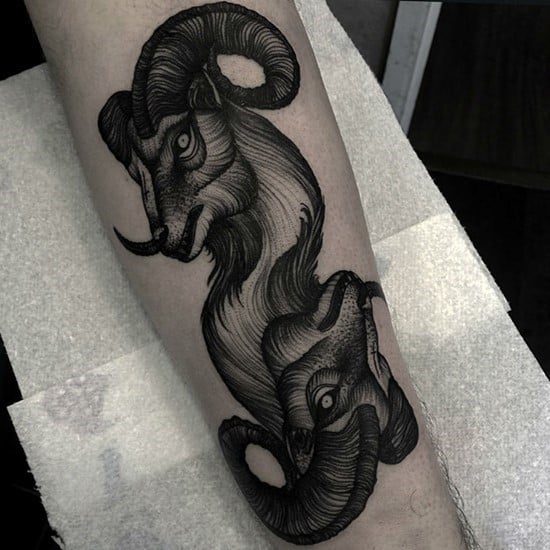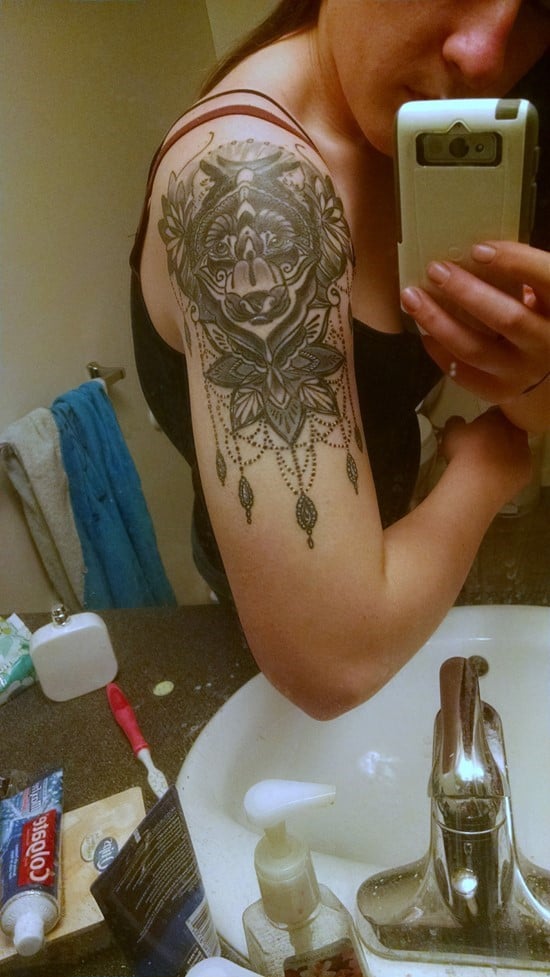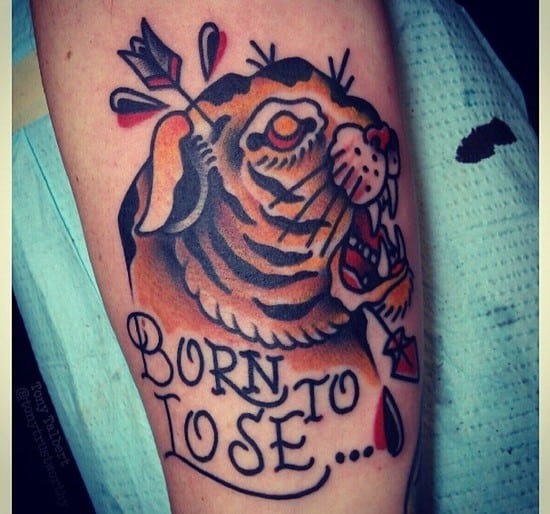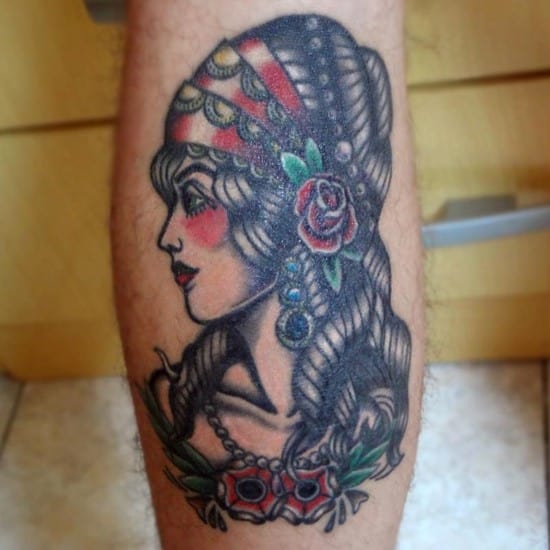Old school tattoos, or American traditional tattoos, are the foundation of tattoo art in the Western world.
For almost a hundred years now, this style has been among the most popular and fascinating movements.
Even the development of new trends and techniques hasn’t put an end to the reign of the classic American sailor tattoo.
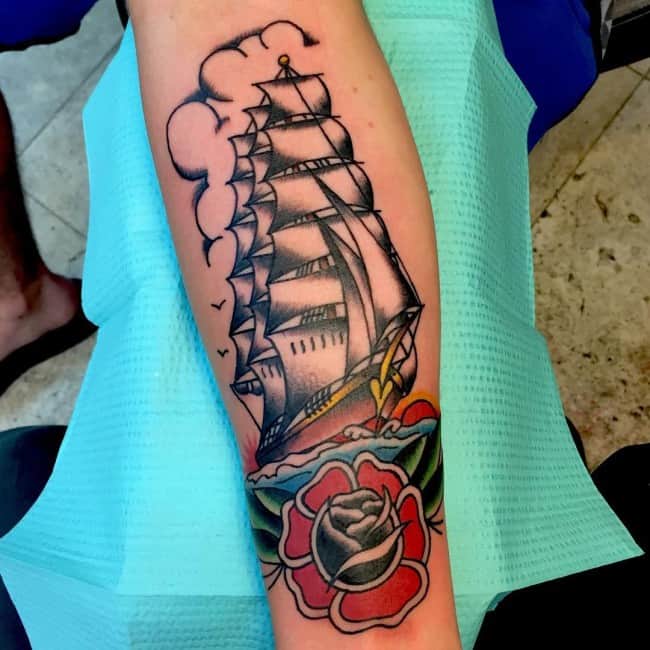
In this article, we’re going to explore the history and meaning behind old school tattoos.
We’re also sharing some of our favorite designs – both original old school tattoos and more modern designs that they’ve inspired.
The history of old school American tattoos
Although there is evidence that various cultures around the world practiced tattooing for thousands of years, this form of body art took a relatively long time to reach Europe and North America.
It was only in the 1700s that European sailors began getting tattoos. The earliest evidence concerns the crew of the British captain James Cook.
During their voyages in the Pacific, sailors would get tattooed by the local communities.

In this manner, for Europeans and later Americans, tattoos became the domain of sailors: only sailors reached areas such as Polynesia, where it was easy to get a tattoo. The first tattooing business in the U.S. wouldn’t open until as late as 1870.
But the tattoos sailors received in Polynesia and other remote areas of the world were different than what we now describe as old school tattoos.
For example, most Polynesian tattoos were tribal patterns similar to the ones that the natives wore.
So what are American traditional tattoos?
What we now call ‘old school tattoos’, or classical tattoo designs, started to appear in the early 1900s and reached their heyday in the 1930s and 40s.
They were relatively simple designs, using color and a bold black outline. Importantly, there was little to no shading – the fill was mostly solid.
In addition to black, the palette originally included only three other colors: red, yellow, and green. Later on, artists began using purple ink as well.
Many people believe that for a traditional American tattoo to appear genuine today, you should stick to only these colors.

In terms of American traditional tattoo designs, some were more popular than others – partly because they held specific meanings for sailors.
Examples of traditional tattoo art include swallows, stars, pin ups, daggers, anchors, sharks, and Hawaiian motifs, among others. We’ll look at these staples of old school tattoos in more detail in the next section.
Not many people are aware that these simplistic designs have a fascinating story to tell. And that story starts with the tattoo legend, Norman Collins – better known as Sailor Jerry.

Sailor Jerry – the father of old school tattoos
Norman Collins – soon to be known as Sailor Jerry – was born in 1911 in Reno, Nevada. By the time he was a teenager, Collins had taken up travelling the country on freight trains.
This is when his passion for tattoos started. Initially, he’d create tattoos with only black ink, drawing them freehand using a needle. Back in those days, tattoos were nowhere near as popular in America as they are today.
In 1927, Collins met Gib ‘Tatts’ Thomas, another legendary tattoo artist, who taught him how to use a tattoo machine. Soon after that, he joined the Navy.

While in the service, Sailor Jerry traveled to China and Japan, where he developed a passion for traditional Asian art. He was the first Westerner to learn from Chinese and Japanese tattoo artists, which helped him develop his own signature style.
This style is what we’d come to know as old school tattoos. By the 1930s, Sailor Jerry had left the Navy and began working as a tattoo artist in Hawaii.
Then, in the 1940s, World War II brought thousands of American soldiers into the area. As it happens, Sailor Jerry’s tattoo studio was in the vicinity of Pearl Harbor.
This was a turning point for American tattoo art: thousands of soldiers on shore leave in Honolulu began frequenting Sailor Jerry’s studio. Before long, Sailor Jerry’s tattoos were known the world over.

In this way, Norman Collins pioneered the American classical tattoo designs.
This was only one of his achievements, though. He was famously always working towards improving his technique, corresponding with Japanese tattoo masters even at a time of open hostility between Japan and the U.S.
He also studied electronics and improved the way tattoo machines work, as well as introducing the use of purple ink in classic American tattoos.

Other notable figures
It would be inaccurate to say that Norman Collins was single-handedly responsible for popularizing classic American designs.
Before and after Sailor Jerry, there were a number of other tattoo artists who contributed to the creation of the style. Gus Wagner, Amund Dietzel, Herbert Hoffman, Bert Grimm and his student Bob Shaw are just some of the most significant figures in the movement.
Ed Hardy and Mike Malone, Sailor Jerry’s apprentices and legends in their own right, are also worth mentioning. It is to them that Collins left his Honolulu tattoo studio before his death in 1973.

Old school tattoo meanings
Armed with an understanding of the context and history behind classic tattoos, we can fully appreciate the American traditional tattoo meanings.
We’ve established that just before and after WWII, these tattoos were the marks of sailors, in the Navy and beyond. Later – from the 50s to the 80s – tattoos in America were marks of counterculture, often of the criminal kind.
As with every other kind of tattoo, old school designs often have personal meanings and only the wearer knows their full significance. Still, Sailor Jerry’s classic designs have universal meanings transcending the personal level of significance.

For example, since the sailor culture is rich in superstition, oftentimes tattoos served as protection from specific dangers that a sailor may encounter.
Many designs also marked achievements, such as reaching a landmark location or sailing a set number of miles.
The designs could also indicate the sailor’s position in the crew’s hierarchy, their status, or rank.
Many of the designs include a ribbon. Writing can be placed there, for example a name, date, or single-word statement. Phrases such as ‘Death before dishonor’ or ‘Homeward bound’ were also common additions.
Back in the day, most old school tattoos were flash designs. A flash is a design displayed in a catalogue or on the wall of a tattoo studio, reused for many customers. Essentially, it’s the opposite of a custom design.

Let’s look at specific traditional tattoo meanings, outlining the details of the most important designs.
Ship tattoos
A ship, as you may expect, represents all aspects of a sailor’s life. After all, a sailor’s entire existence is bound up in the vessel on which they work.

The ship is more than a workplace to a sailor. It also represents the freedom and adventure they experience while sailing.
Back in the day, a tattoo with a fully rigged ship meant that the sailor had travelled around Cape Horn in Chile.

A major milestone on the Clipper route – a traditional sailing route between Europe and the Far East, Australia, and New Zealand – Cape Horn was infamous for the extremely dangerous sailing conditions.

Anchor tattoos
Anchors are among the old school tattoo designs that survived the transformations in tattoo art through the decades. They are as popular in tattoos nowadays – in all styles, from geometric to watercolor – as they had been back in Sailor Jerry’s heydey.
An anchor represents protection, stability, and safety. On an active ship, it’s the strongest symbol of security in a sailor’s life.
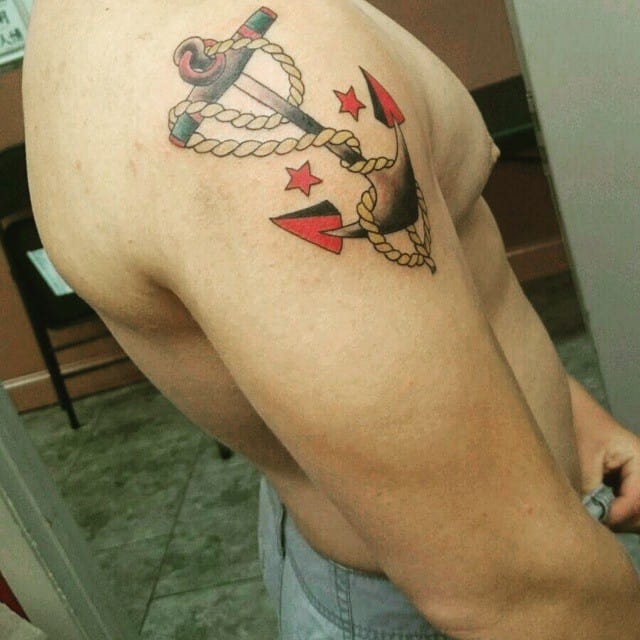
Today, anchors still hold the same significance in tattoos. They represent the idea of security, as well as symbolizing being grounded and balanced.
Often, traditional tattoos with an anchor would also include the name of the sailor’s girlfriend or wife, or the word ‘Mom’.
This is a testament to how the person ‘grounds’ the sailor. It could also be a reminder of someone who’s waiting for them back on land.

Furthermore, the symbol of the anchor in a sailor’s tattoo refers to achieving the rank of Boatswain or Chief. It can also signify the milestone of having sailed across the Atlantic.
Swallow tattoos
A great example of small traditional tattoos, swallows – like anchors – are still highly popular today.

These small birds are famous for travelling long distances as part of their migration pattern, always ultimately returning home. As such, they represent a safe return home for a sailor.
Old school swallow tattoos are also marks of achievements for a sailor. Back when tattoos were first becoming popular, new sailors about to set out to sea would get a swallow design.

Later on, each swallow came to represent 5,000 miles sailed. In some circles, they indicated that the sailor has crossed the equator during his travels.
Certain placements for swallow tattoos have their own special significance.
A pair of swallows tattooed on the chest is supposed to carry the sailor’s soul to heaven if he drowns. Meanwhile, a swallow on the back of the hand indicates a good fist fighter.
Like all birds, swallows can also be symbols of freedom in tattoos of any style. Because they mate for life, they also represent one true love.
Heart tattoos
A sailor’s life involves long periods of time spent away from home. A heart tattoo is a reminder of loved ones.
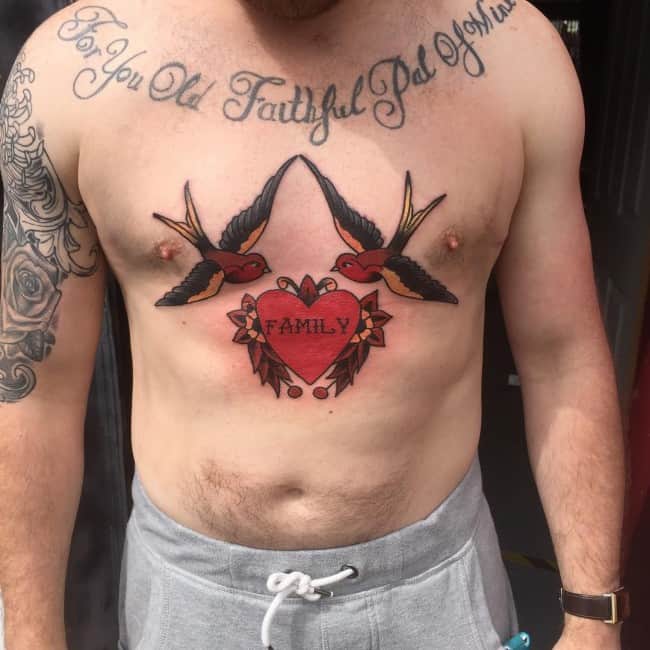
Getting a heart tattoo – often with a name – is a way to take a loved one along for the journey.

Star tattoos
The distinctive nautical star is an important element of old style tattoos.

This symbol represents the North Star, used as the main reference point for maritime navigation. It’s also a reference to the rose of the compass – the lines indicating the cardinal directions of North, South, East, and West.
Therefore, it’s literally a guiding star. The tattoo is a good luck charm for a sailor, reflecting hopes of a safe return home and reminding them of what’s important.
For some sailors, nautical star tattoos represent certain achievements and experiences. For example, sailing a certain amount of miles may warrant a star tattoo, or surviving a particularly dangerous voyage.
Two nautical stars on the chest are the marks of a good fighter, and are a means of warning others not to mess with the sailor. Interestingly, this likely comes from the light signal that a ship displays to others as an order to yield and give way – starboard and port lights on.
Similarly, some accounts say that a red and green nautical stars on the chest of a sailor mean that he won a bar fight in a foreign port.
Shark tattoos
In traditional tattoos, sharks are symbolic of what the sailor has overcome and what he’s willing to do.
They represent strength of character and body, as well as the qualities of being fierce and unstoppable.

Shark tattoos were also protective charms. In case the sailor fell into the water, a shark tattoo would supposedly protect him from being eaten by a real shark.
Eagle tattoos
Eagles in old school tattoos usually represent America.
Sailor Jerry often used eagles in his designs, frequently in the company of the American flag. It is said that to him, the eagle represented an idealized version of America.
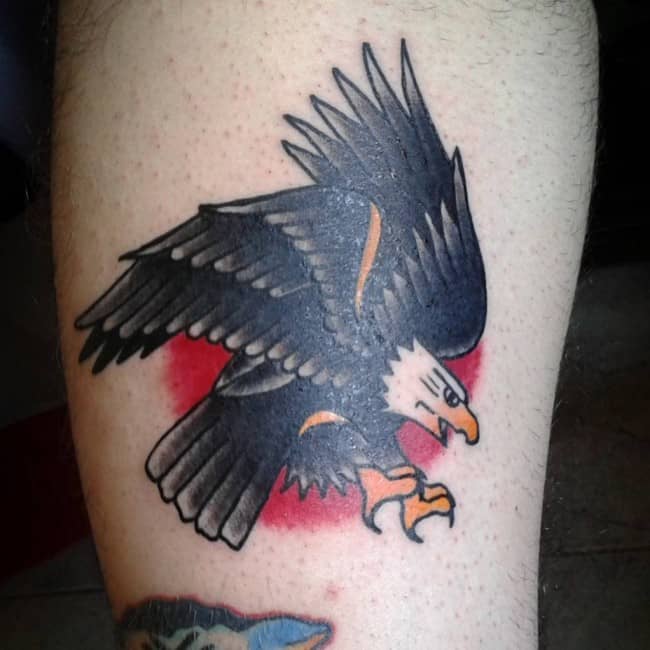
In general, eagles also symbolize freedom and courage. Because they fly so high up in the sky from the ground, they represent man’s connection to the divine.
An eagle killing a snake is also a common motif in old school tattoos. Unsurprisingly, this design usually represents war.

This can be a real conflict between two nations or physical entities, or it can mean a metaphorical clash. Sometimes, it stands for an inner conflict between two sides of one person’s character.
Eagles usually represent positive, admirable qualities, and serpents often get the rough end of the deal – symbolizing treachery and lies, among other things. For this reason, this design can represent the triumph of good over evil.
Interestingly, the Mexican coat of arms depicts an eagle devouring a rattlesnake. It has been inspired by a legend, according to which the Aztecs would build a new city in a spot where they saw an eagle eating a snake.
Snake tattoos
Snakes, as we’ve just seen, are often a negative symbol. Due largely to the unenviable role that the snake plays in the Bible, snakes are associated with lies and betrayal.

However, there have been plenty positive associations with snakes in different cultures over the centuries.
In old school tattoos, snakes tend to mean danger. Specifically, the danger the sailor can represent when crossed. They thus serve as protective symbols against evil and treachery.
In his snake tattoos, Sailor Jerry most often depicted cobras, usually mid-strike.
Pharaoh’s Horses
This classic design completely mystifies most people, as its meaning is not immediately clear.
In fact, the traditional tattoo of three horses heads – always arranged in the same pattern – is a reference to the Bible.
Specifically, to the Pharaoh’s Horses, which appear as Moses closes the Red Sea. Disregarding the storm and the volatile waters, the horses charge in attempted pursuit.
Although it’s technically a Bible reference, this tattoo design doesn’t necessarily reflect strong religious faith.
It’s generally accepted that the Pharaoh’s Horses design means fortitude, determination, and strength in the face of adversity. It also symbolizes the longing for freedom and the triumph of spirit.
You’ll notice that the horses are always shown in the same way in these tattoos. The particular composition of the design comes from a 19th century paining by John Fredrick Herring Sr.


Pig and chicken tattoos
This is an odd pairing that deserves an extended explanation.
Stories claim that during shipwrecks, if there was lifestock on board – such as farm animals – they were the most likely to survive.
This might seem counter-intuitive – after all, pigs don’t strike most people as the best swimmers. (Neither do chickens, for that matter.)

However, the point is that animals such as pigs and chickens were kept in wooden shipping crates. If the ship was destroyed, these crates would stay afloat – thus saving the animals while the sailors may have perished.
This is where this pair of tattoos comes from. Traditionally, the pig tattoo should be placed on the left foot, and the chicken (or rooster) on the right. Together, they would protect the sailor from drowning if the ship was destroyed.
Hawaii-themed traditional tattoos
If you’ve read the history of old school American tattoos above, the presence of Hawaiian themes probably won’t surprise you.
Sailor Jerry settled in Hawaii after leaving the Navy, and spent most of his life there, working as a tattoo artist. Hawaiian motifs were a part of his signature style, and they remained popular in the broader old school tradition.
For sailors and soldiers, a Hawaiian classic tattoo – often depicting a hula girl – could simply mean that they were stationed in Hawaii.
Pin up girl tattoos
Pin ups were incredibly popular during World War II, often used in official wartime propaganda. Their presence in classic tattoos is mostly just a reflection of the times.

For sailors, pin up tattoos could be a reminder of a specific woman back home, or they could simply be a permanent alternative (or addition!) to having a pin up poster.
Final words
There’s more than meets the eye to old school tattoos. The extensive range of meanings and significance are certainly appealing, as is the air of adventure that the life of a sailor – signified by a vintage tattoo – represents.
Hopefully, you’re now well-equipped to decide on an old school tattoo of your very own. Take a look through the gallery below for more traditional tattoo ideas and some visual inspiration!





